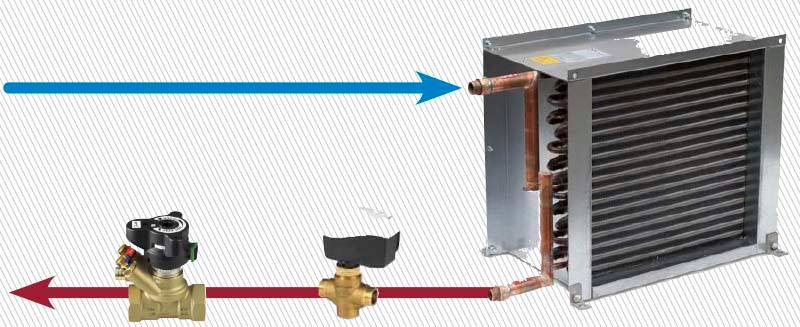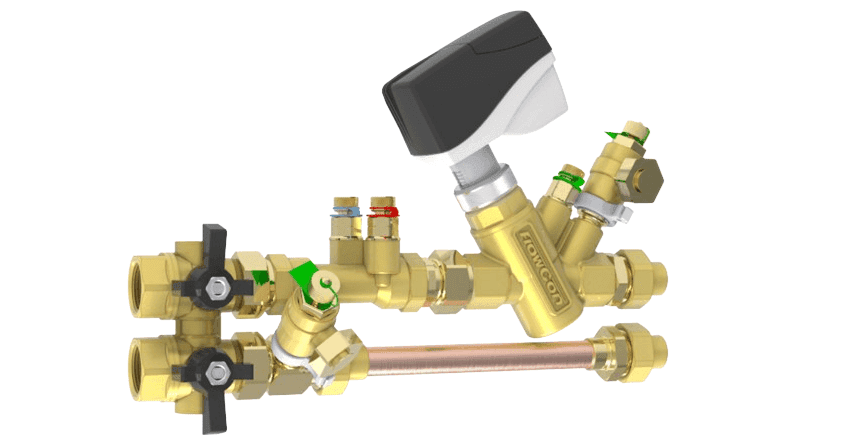Control Valve Authority - Kvs Coefficient
6 marca 2024 | Heating
The flow coefficient Kv (or kvs) is one of the key parameters that allows determining the optimal valve for a given hydraulic system.

Valve kvs coefficient
This coefficient results from the relationship between flow rate and pressure losses generated during fluid flow through the valve. Kv is defined as the amount of water (expressed in m3/h) that causes a pressure drop of 1 bar across the valve. Generally speaking, the larger the coefficient, the smaller the pressure drop across the valve.
The formula used to determine the Kv value, connecting pressure drop with flow rate, is Kv = Q / √ΔP, where:
- Q (m3/h) is the flow rate
- ΔP (bar) is the pressure drop between the valve inlet and outlet points.
Using the above formula, we can calculate the actual pressure drop across the valve at a given flow rate after transformation. The Kvs coefficient value is always provided by the valve manufacturer. The kvs valve calculator can be found in our application at this link
Control Valve Authority
In heating or cooling installations, control valves play a key role in precise flow control of the medium. Besides parameters such as size, type, and material, an important characteristic of each control valve is its authority.
Valve authority defines its ability to regulate flow in a given system. The basic principle is as follows: the higher the resistance (pressure drop) of the control valve in a given circuit relative to the total pressure drop of that circuit, the greater the influence (authority) the control valve has on the flow rate, meaning good control properties.
Authority is typically defined as the ratio of the pressure drop across the control valve when it is fully open (Δpz) to the sum of this drop and the pressure drop across the remaining part of the circuit (Δpstr).
where:
- az - control valve authority
- Δpz - pressure drop across the control valve [bar]
- Δpstr - pressure drop across the remaining circuit elements (except the valve) [bar] *pressure units can be different provided they are the same in both cases.
We can use this analogy. When we say someone has great authority, it means we value that person. They are significant and have influence. Similarly with a control valve. When a valve has low authority, its operation weakly affects the functioning of the circuit in which it is located. This means that initial valve closure does not sufficiently restrict the flow, resulting in poor control of the given circuit. In the case of a valve with high authority, even minimal closure can significantly change the flow, allowing for precise control.

Why is valve authority important?
Authority is an important factor in the proper selection of a control valve. Oversized control valves (high kvs) will be characterized by low pressure drop, which is beneficial in terms of energy consumption, but will adversely affect flow control. Therefore, oversized control valves tend to operate near the closed position most of the time to provide acceptable flow control.
If the control valve is too small, the pressure drop across it (ΔPv) increases. Every valve movement will have a strong effect on the flow, providing very good control. Small control valves are generally good for control but will have an adverse effect on energy consumption (high resistance).
It is clear that there is a compromise between control valve control and pressure drop. Practical control valve selection requires finding a balance between these two aspects.
Generally accepted that:
- az = 0 - 0.25 provides from unstable to average control with low pressure drop
- az = 0.25 - 0.5 provides from average to good control with reasonable pressure drop
- az = 0.5 - 1.0 provides from good to excellent control, but with high pressure drop For practical reasons, control valves are selected to have an authority of 0.3 - 0.7, which provides an appropriate compromise between control and pressure drop. Both parameters should be considered simultaneously to avoid high, unacceptable pressure drop. Usually, an authority of 0.5 is aimed for, but this depends on the availability of actual Kv flow coefficients of control valves.
The valve authority calculator can be found here
Back to articles list